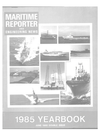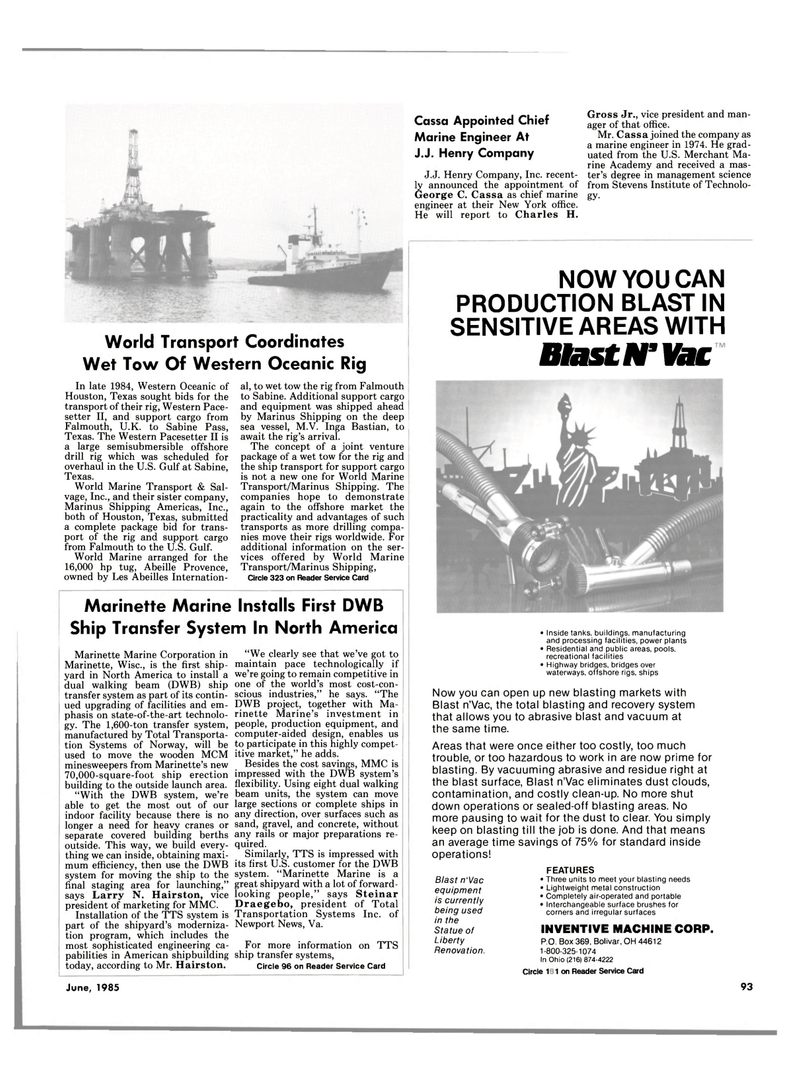
Page 95: of Maritime Reporter Magazine (June 1985)
Read this page in Pdf, Flash or Html5 edition of June 1985 Maritime Reporter Magazine
World Transport Coordinates
Wet Tow Of Western Oceanic Rig
In late 1984, Western Oceanic of
Houston, Texas sought bids for the transport of their rig, Western Pace- setter II, and support cargo from
Falmouth, U.K. to Sabine Pass,
Texas. The Western Pacesetter II is a large semisubmersible offshore drill rig which was scheduled for overhaul in the U.S. Gulf at Sabine,
Texas.
World Marine Transport & Sal- vage, Inc., and their sister company,
Marinus Shipping Americas, Inc., both of Houston, Texas, submitted a complete package bid for trans- port of the rig and support cargo from Falmouth to the U.S. Gulf.
World Marine arranged for the 16,000 hp tug, Abeille Provence, owned by Les Abeilles Internation- al, to wet tow the rig from Falmouth to Sabine. Additional support cargo and equipment was shipped ahead by Marinus Shipping on the deep sea vessel, M.V. Inga Bastian, to await the rig's arrival.
The concept of a joint venture package of a wet tow for the rig and the ship transport for support cargo is not a new one for World Marine
Transport/Marinus Shipping. The companies hope to demonstrate again to the offshore market the practicality and advantages of such transports as more drilling compa- nies move their rigs worldwide. For additional information on the ser- vices offered by World Marine
Transport/Marinus Shipping,
Circle 323 on Reader Service Card
Marinette Marine Installs First DWB
Ship Transfer System In North America
Marinette Marine Corporation in
Marinette, Wise., is the first ship- yard in North America to install a dual walking beam (DWB) ship transfer system as part of its contin- ued upgrading of facilities and em- phasis on state-of-the-art technolo- gy. The 1,600-ton transfer system, manufactured by Total Transporta- tion Systems of Norway, will be used to move the wooden MCM minesweepers from Marinette's new 70,000-square-foot ship erection building to the outside launch area. "With the DWB system, we're able to get the most out of our indoor facility because there is no longer a need for heavy cranes or separate covered building berths outside. This way, we build every- thing we can inside, obtaining maxi- mum efficiency, then use the DWB system for moving the ship to the final staging area for launching," says Larry N. Hairston, vice president of marketing for MMC.
Installation of the TTS system is part of the shipyard's moderniza- tion program, which includes the most sophisticated engineering ca- pabilities in American shipbuilding today, according to Mr. Hairston. "We clearly see that we've got to maintain pace technologically if we're going to remain competitive in one of the world's most cost-con- scious industries," he says. "The
DWB project, together with Ma- rinette Marine's investment in people, production equipment, and computer-aided design, enables us to participate in this highly compet- itive market," he adds.
Besides the cost savings, MMC is impressed with the DWB system's flexibility. Using eight dual walking beam units, the system can move large sections or complete ships in any direction, over surfaces such as sand, gravel, and concrete, without any rails or major preparations re- quired.
Similarly, TTS is impressed with its first U.S. customer for the DWB system. "Marinette Marine is a great shipyard with a lot of forward- looking people," says Steinar
Draegebo, president of Total
Transportation Systems Inc. of
Newport News, Va.
For more information on TTS ship transfer systems,
Circle 96 on Reader Service Card
Cassa Appointed Chief
Marine Engineer At
J.J. Henry Company
J.J. Henry Company, Inc. recent- ly announced the appointment of
George C. Cassa as chief marine engineer at their New York office.
He will report to Charles H.
Gross Jr., vice president and man- ager of that office.
Mr. Cassa joined the company as a marine engineer in 1974. He grad- uated from the U.S. Merchant Ma- rine Academy and received a mas- ter's degree in management science from Stevens Institute of Technolo-gy-
NOW YOU CAN
PRODUCTION BLAST IN
SENSITIVE AREAS WITH Blast IT Vac • Inside tanks, buildings, manufacturing and processing facilities, power plants • Residential and public areas, pools, recreational facilities • Highway bridges, bridges over waterways, offshore rigs, ships
Now you can open up new blasting markets with
Blast n'Vac, the total blasting and recovery system that allows you to abrasive blast and vacuum at the same time.
Areas that were once either too costly, too much trouble, or too hazardous to work in are now prime for blasting. By vacuuming abrasive and residue right at the blast surface, Blast n'Vac eliminates dust clouds, contamination, and costly clean-up. No more shut down operations or sealed-off blasting areas. No more pausing to wait for the dust to clear. You simply keep on blasting till the job is done. And that means an average time savings of 75% for standard inside operations!
FEATURES • Three units to meet your blasting needs • Lightweight metal construction • Completely air-operated and portable • Interchangeable surface brushes for corners and irregular surfaces
INVENTIVE MACHINE CORP.
P.O. Box 369, Bolivar, OH 44612 1-800-325-1074
In Ohio (216) 874-4222
Circle 311 on Reader Service Card
Blast n'Vac equipment is currently being used in the
Statue of
Liberty
Renovation.
June, 1985 93

 94
94

 96
96
